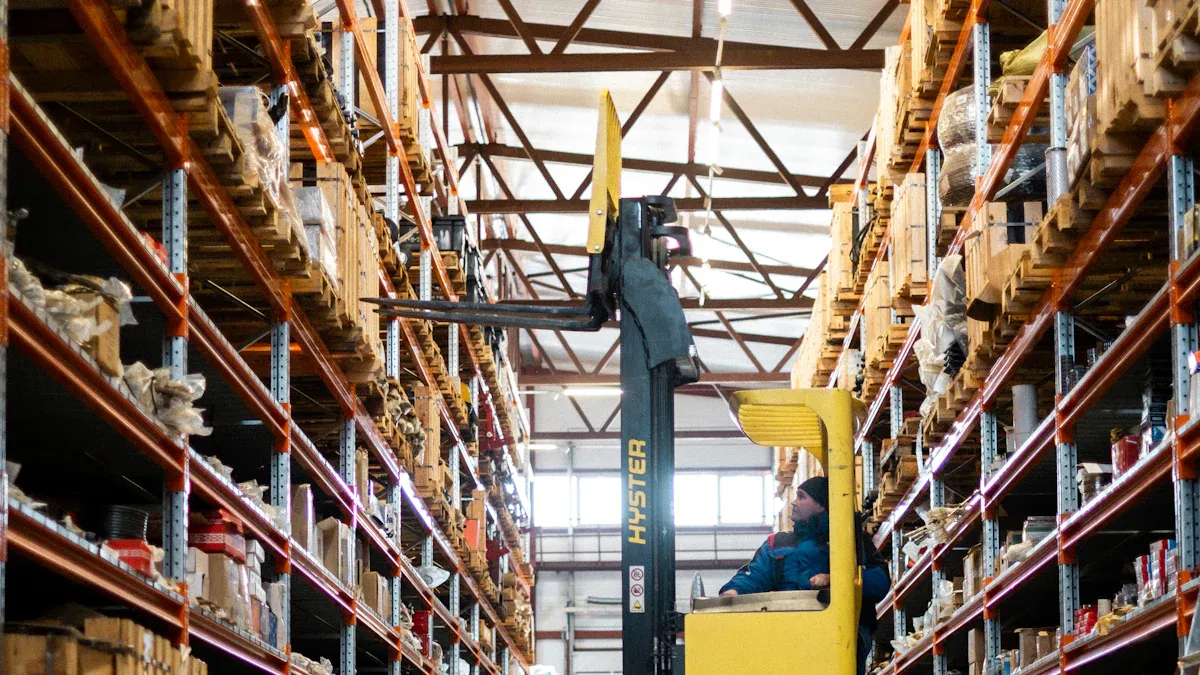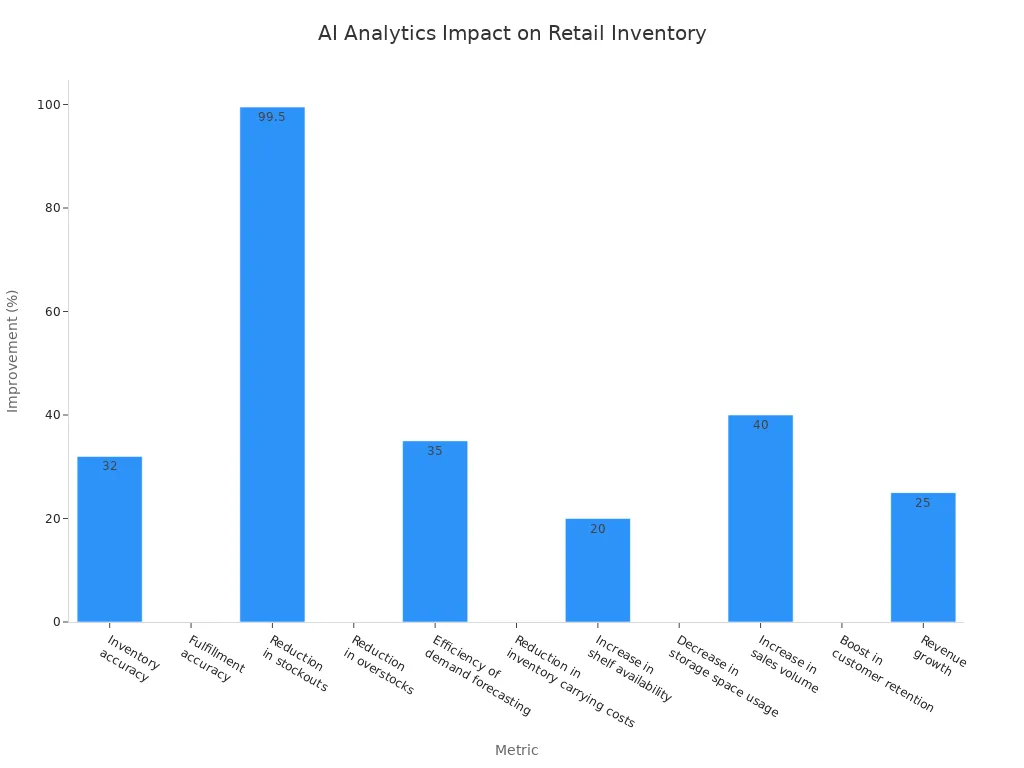Ai retail analytics for inventory management

Imagine walking into a store and always finding the products you want on the shelf. Today, ai retail analytics helps you manage inventory with greater accuracy and speed. You see retailers using smart tools like machine learning and IoT to move away from manual tracking. These technologies improve efficiency and cut costs.
Inventory management is vital for keeping customers happy and boosting profits.
Benefit | Impact on Retail Success |
|---|---|
Reduced holding costs | Saves money and reduces waste. |
Improved customer satisfaction | Ensures products are available, leading to repeat purchases. |
Minimized stockouts | Prevents missed sales opportunities. |
Improved cash flow | Allows for investment in popular products. |
Enhanced operational efficiency | Supports growth and better customer experiences. |
Key Takeaways
AI retail analytics improves inventory management by predicting demand accurately, helping retailers avoid stockouts and excess inventory.
Using real-time data and machine learning, retailers can automate reordering processes, ensuring popular items are always in stock.
Implementing AI tools can lead to significant cost savings, with some retailers reporting up to a 40% reduction in inventory costs.
Training staff on new AI systems is crucial for successful implementation, as it helps them understand and utilize the technology effectively.
Start your AI journey by assessing your current inventory processes, selecting the right tools, and piloting the system to ensure it meets your needs.
AI Retail Analytics Impact
Inventory Optimization
You can use ai retail analytics to keep your store shelves stocked with the right products. These smart systems help you avoid having too much or too little inventory. AI algorithms look at many data points, such as customer demand and supply chain changes, to predict what you need. This means you do not waste money on extra stock or lose sales because of empty shelves.
AI-driven inventory systems use real-time data and predictive analytics. You get dynamic updates to your inventory levels, unlike traditional methods that rely on static rules.
Retailers have seen big improvements after switching to ai retail analytics. Take a look at the table below to see how much accuracy has improved:
Improvement Type | Percentage Improvement |
|---|---|
Reduction in excess inventory | 30% |
Reduction in stockouts | 25% |
Improvement in inventory turnover | 89% |
Walmart uses agentic AI to make its inventory management more efficient. Smart shelves and AI forecasting help reduce waste and keep products available for customers. Regional Retailer Inc. saw a 40% drop in inventory costs and a 25% decrease in stockouts after using AI tools.
Here are some ways AI inventory optimization works for you:
Automates reordering so you never run out of popular items.
Predicts demand to prevent overstocking.
Minimizes costs from stockouts or excess inventory.
Uses deep learning to analyze sales trends and outside factors.
Amazon’s predictive inventory system uses deep learning to study past sales, seasonal changes, and other influences. This helps you keep just the right amount of stock. AI and robotics can save up to 25% in inventory costs and boost efficiency by 30% in fulfillment centers.
Demand Prediction
You can rely on ai retail analytics to forecast demand with high accuracy. These systems use advanced models to predict what customers will buy next. Manual forecasting methods only reach about 70% accuracy, but AI-based forecasting can achieve rates between 90% and 95%.
Method | Accuracy Rate |
|---|---|
Manual Forecasting | 70% |
AI-Based Forecasting | 90–95% |
Retailers like Walmart, Zara, Amazon, and Starbucks have used AI demand prediction to improve stock availability and reduce lost sales. For example, Zara’s AI forecasting led to a 40% reduction in excess inventory. This means you can sell more products at full price and avoid markdowns.
"Zara's use of AI forecasting has led to a significant reduction of 40% in excess inventory, showcasing how AI can transform inventory management and reduce stockouts."
Here is how some top retailers benefit from AI demand prediction:
Retailer | AI Application | Impact on Stock Availability and Sales |
|---|---|---|
Walmart | Eden system | Improved fresh food forecasting, cutting $86 million in food waste and boosting forecasting accuracy. |
Zara | AI analysis | Contributed to 85% of inventory selling at full price, reducing reliance on markdowns. |
Amazon | Sophisticated AI forecasting | Reduced excess stock by 15-20%, saving on inventory holding costs. |
Starbucks | AI platform | Improved inventory ordering, leading to a 30% boost in ROI for stores. |
You can see that ai retail analytics helps you match your supply with real demand. This reduces waste, saves money, and keeps your customers happy. When you use AI tools, you make smarter decisions and keep your store running smoothly.
Key Technologies

Machine Learning
You can use machine learning to make smarter decisions about your store’s inventory. Machine learning models study past sales data and spot patterns that affect demand. These models process large amounts of information from different sources. They help you predict how much of each product you need for every store and channel. Machine learning also looks at price changes and outside factors, so you can plan for sales or promotions.
Some common machine learning techniques in ai retail analytics include:
Inventory forecasting: Predicts future demand by analyzing sales history.
Demand prediction: Uses real-time and past data to see when customers will buy more or less.
Inventory segmentation: Groups products by demand patterns to help you manage them better.
Machine learning makes demand forecasting easier by automatically considering many factors, so you do not have to adjust things by hand.
Real-Time Data
Real-time data helps you keep track of your inventory every minute. You can see what is selling and what needs restocking right away. This quick view lets you respond fast to changes in demand. You avoid running out of popular items or having too much of something that does not sell.
Retailers use many real-time data sources, such as:
Point-of-sale systems
Warehouse management systems
IoT sensors
External data like weather or market trends
For example, Amazon uses machine learning to predict demand and reorder products automatically. Walmart uses IoT sensors to watch inventory in real time, which cuts down on stockouts.
Real-time data gives you a clear picture of your inventory across all locations and helps you make better decisions.
Automation
Automation saves you time and reduces mistakes in inventory management. AI can handle tasks like updating stock levels and reordering products. It checks sales data all the time and creates purchase orders when needed. This means you always have the right amount of stock.
Common automated tasks in ai retail analytics include:
Smart replenishment: Keeps shelves stocked with high-demand items.
Dynamic pricing: Changes prices based on demand and inventory.
Predictive maintenance: Schedules repairs to avoid equipment problems.
Exception handling: Spots issues and works with staff to fix them, learning from each case.
Automation improves efficiency, reduces waste, and makes sure your customers find what they want.
Solving Inventory Challenges

Reducing Stockouts
You want your customers to always find what they need on your shelves. Stockouts can lead to lost sales and unhappy shoppers. AI-powered systems help you spot and fix these problems before they happen. With real-time monitoring and predictive analytics, you can keep your inventory at the right level.
AI-driven forecasting predicts when you might run out of stock and tells you how long the shortage could last. This helps you act fast to keep products available.
Real-time inventory software alerts you to possible shortages before they happen. You can restock quickly and avoid empty shelves.
Continuous monitoring lets you fix problems as soon as they appear. You can adjust your stock based on changes in demand.
AI systems look at past sales data to see trends and suggest when to reorder.
Predictive analytics can cut stockouts by up to 35% and reduce extra inventory by 28%.
Some companies have seen a 25% drop in stockouts after using AI tools. One sporting goods retailer even reduced stockouts by 35% with AI demand forecasting.
AI retail analytics helps you keep your shelves full and your customers happy.
Minimizing Waste
You also want to avoid wasting products, especially items that expire or do not sell quickly. AI tools help you spot slow-moving or perishable goods and take action before they become waste.
AI Technique | Benefits |
|---|---|
Predictive Analytics | Forecasts expiry dates, so you can offer discounts in time. |
Real-time Monitoring | Tracks stock and expiration dates, lowering waste risk. |
Automated Replenishment | Orders the right amount based on expiry predictions. |
Machine Learning Algorithms | Finds products at risk of expiring by studying sales patterns. |
Dynamic Pricing Strategies | Lowers prices for items close to expiry to boost sales. |
AI-driven Alerts | Notifies staff about soon-to-expire products for quick action. |
Supply Chain Integration | Improves ordering to prevent extra inventory. |
Consumer Engagement | Shares freshness tips to help sell products faster. |
You can see the results of using AI in the chart below:

AI systems can boost inventory accuracy from 63% to 95% and raise fulfillment accuracy to 99.5%. You can also cut overstocks by up to 20% and reduce storage space use by 25%. These improvements help you save money, keep shelves stocked, and make your business more efficient.
Implementation Steps
Adopting ai retail analytics for inventory management works best when you follow a clear, step-by-step plan. Each stage helps you build a strong foundation and avoid common mistakes. Here is how you can get started:
Assessment
Start by checking if your business is ready for AI-powered inventory management. You need to look at your goals, your data, and your team’s skills. Here are the main steps:
Set clear business goals for your inventory management.
Make sure your data is accurate and easy to access.
Build a team with AI knowledge or hire experts.
Review your current technology and choose the right partners.
Protect customer data with strong security.
Begin with small pilot projects to test your ideas.
You should also clean up your product details, sales history, and supplier data. This makes your predictions more reliable.
Tip: Standardizing your product information and cleaning your sales data will help your AI system work better.
You can track your progress by looking at key performance indicators (KPIs):
KPI | Description |
|---|---|
Inventory Turnover Ratio | Shows how often you sell and replace inventory. Higher is better. |
Stockout Rate | Counts how often you run out of products. Lower is better. |
Carrying Cost of Inventory | Measures how much it costs to store your products. |
Order Fulfillment Rate | Tells you how many orders you fill on time and in full. |
Lead Time | Tracks how long it takes to get new stock from suppliers. |
Tool Selection
Choosing the right AI tools is important for your success. You need to match your business needs with the right features. Here are some things to look for:
Criteria | Description |
|---|---|
Understand your inventory needs | Find out what problems you want to solve. |
Deployment options | Decide if you want cloud or on-premises solutions. |
Customization | Make sure the tool fits your industry. |
Cost considerations | Check the total cost and possible savings. |
Vendor support | Look for good customer service and updates. |
User-friendliness | Pick a tool that is easy to use and comes with training. |
Data security and compliance | Choose tools that keep your data safe. |
Some popular AI inventory management tools include:
Oracle Inventory Management for real-time tracking and automatic restocking.
SAP Inventory Manager, which uses machine learning for better slotting.
Microsoft Dynamics 365 Supply Chain Management with an AI assistant for planning.
Manhattan Active for RFID-based tracking.
Blue Yonder for dynamic inventory allocation.
Note: Make sure your chosen tool gives you a clear view of your inventory, live updates, and strong analytics.
Data Integration
You need to connect your new AI system with your current data sources. This step is key for getting accurate results. Focus on these best practices:
Best Practice | Description |
|---|---|
Seamless Integration | Link your AI tool with POS, CRM, ERP, and online stores. |
Data Cleansing | Remove errors and check your data for accuracy. |
API Access | Use APIs and cloud connections for easy data sharing. |
High-quality data helps your AI system learn and make better predictions. Many retailers face problems with data silos, where information is stuck in separate systems. About 65% of retail leaders say this slows down their AI projects. You can solve this by making sure all your systems talk to each other and by cleaning your data before you start.
Remember: AI models need accurate and up-to-date data. Bad data leads to bad results.
Piloting
Before you roll out your AI system everywhere, test it with a small pilot. This helps you spot problems early and make improvements. Here is a simple way to run a pilot:
Pick one product category or store region to start.
Use your current inventory and sales data for testing.
Compare AI forecasts with manual calculations.
Track important metrics like forecasting accuracy and error rates.
Expand the pilot by adding more products or locations after a few weeks.
Automate insights and set up alerts for your team.
During the pilot, aim to improve forecasting accuracy to 97% and reduce errors by 15%. Make sure your system gives you a list of actions for your planning meetings.
Training
Your team needs to know how to use the new AI tools. Good training helps everyone feel confident and ready for change. Here are some ways to train your staff:
Use AI-powered training programs that adjust to each person’s needs.
Offer video coaching and fun challenges to keep learning interesting.
Let new employees shadow experienced staff to learn on the job.
Use performance analytics to see where more help is needed.
Note: Change can be hard. About 70% of digital projects fail because people resist new systems. Training helps your team understand how AI works and why it matters.
Make sure everyone knows how to read AI reports and use the insights. This will help you get the most value from your investment in ai retail analytics.
You can transform your inventory management with ai retail analytics. Retailers report long-term benefits such as improved demand forecasting, optimized stock levels, and reduced costs:
Benefit | Description |
|---|---|
Improve demand forecasting | Predictive analytics enables accurate demand predictions based on historical and current data. |
Optimize inventory levels | AI-based intelligence ensures products are stocked according to real-time or predicted demand. |
Automation cuts down on manual work and errors, allowing staff to focus on higher-value tasks. | |
Improve customer satisfaction | AI enhances order fulfillment speed and accuracy, helping businesses retain customers. |
Increase operational efficiency | AI streamlines resource-heavy processes, enhancing efficiency from procurement to distribution. |
Access real-time insights | AI transforms raw data into actionable insights for proactive decision-making. |
To get started, follow these steps:
Audit your inventory and gather sales data.
Research and shortlist AI solutions.
Request demos and trials.
Set up your chosen system and train your team.
Monitor performance and adjust for best results.
Start evaluating your current inventory process today to stay ahead in retail.
FAQ
What is AI retail analytics for inventory management?
AI retail analytics uses smart computer systems to help you track, predict, and control your store’s inventory. You get faster updates, better forecasts, and fewer mistakes compared to manual methods.
How does AI help reduce stockouts?
AI systems watch your sales and inventory in real time. You get alerts when products run low. The system predicts demand, so you can reorder before shelves go empty.
Can small retailers use AI inventory tools?
Yes, you can use AI tools even if you run a small store. Many solutions offer easy setup and affordable pricing. You do not need a big budget or a large team.
What data do I need for AI inventory management?
You need sales history, product details, and supplier information. Clean and accurate data helps AI make better predictions. Most systems connect with your point-of-sale and warehouse software.
See Also
Revolutionizing Online Store Management With AI-Driven Tools
Understanding the Growth of AI-Enhanced Corner Stores
The Future of Retail: Embracing AI-Driven Stores
Contrasting Amazon Go With Cloudpick: A Retail Analysis
Examining Walgreens Self-Checkout: Benefits and Hurdles in Retail
